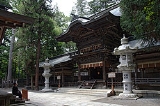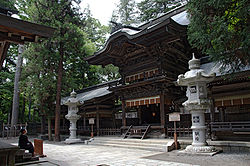
Suwa Taisha
Encyclopedia

Nagano Prefecture
is a prefecture of Japan located in the Chūbu region of the island of Honshū. The capital is the city of Nagano.- History :Nagano was formerly known as the province of Shinano...
, Japan. Over 1200 years old, it is one of the oldest shrines in existence, and is mentioned in the Kojiki
Kojiki
is the oldest extant chronicle in Japan, dating from the early 8th century and composed by Ō no Yasumaro at the request of Empress Gemmei. The Kojiki is a collection of myths concerning the origin of the four home islands of Japan, and the Kami...
, an 8th century text. It consists of four building complexes, the , the , the , and the .
History
Like others among Japan's oldest shrines, Suwa Taisha does not have a hondenHonden
The , is the most sacred building at a Shinto shrine, intended purely for the use of the enshrined kami, usually symbolized by a mirror or sometimes by a statue. The building is normally in the rear of the shrine and closed to the general public. In front of its usually stands the haiden, or...
, the building that normally enshrines a shrine's kami
Kami
is the Japanese word for the spirits, natural forces, or essence in the Shinto faith. Although the word is sometimes translated as "god" or "deity", some Shinto scholars argue that such a translation can cause a misunderstanding of the term...
. This is because its objects of worship (shintai
Shintai
In Shinto, , or when the honorific prefix go- is used, are physical objects worshiped at or near Shinto shrines as repositories in which spirits or kami reside...
) are the mountain the shrine stands on (at the Kamisha) and a (at the Shimosha).
Suwa shrine was designated as the chief Shinto shrine (ichinomiya) for the former Shinano province
Shinano Province
or is an old province of Japan that is now present day Nagano Prefecture.Shinano bordered on Echigo, Etchū, Hida, Kai, Kōzuke, Mikawa, Mino, Musashi, Suruga, and Tōtōmi Provinces...
.
From 1871 through 1946, Suwa was officially designated one of the , meaning that it stood in the highest range of ranked, nationally significant shrines
Modern system of ranked Shinto Shrines
The The The (sometimes called simply , was an organizational aspect of the establishment of Japanese State Shinto. This system classified Shinto shrines as either official government shrines or "other" shrines...
.
Branch shrines
Suwa Taisha's component shrines are located in ChinoChino, Nagano
is a city located in Nagano, Japan.As of 2003, the city has an estimated population of 55,902 and the density of 209.83 persons per km². The total area is 266.41 km².The city was founded on August 1, 1958.- Geography :*mountain**Mount Yatsugatake...
, Suwa
Suwa, Nagano
is a city located in Nagano, Japan.As of October 1, 2010, the city had an estimated population of 51,084 and a density of 468.40 persons per km². The total area of the city is 109.06 km²....
and Shimo Suwa
Shimosuwa, Nagano
is a town located in Suwa District, Nagano, Japan. It is located on Lake Suwa, a large, natural lake surrounded by mountains.As of 2006, the town has an estimated population of 22,421. The total area is 66.90 km²....
, next to Lake Suwa
Lake Suwa
is a lake in the central part of Nagano Prefecture, Japan. It ranks 24th in Japan in surface area.Lake Suwa is the site of , an interesting natural phenomenon. The lake has a natural hot spring under the surface, so that when the top freezes in the winter, the lower waters are still warm and...
.
Suwa Taisha is the head shrine of the Suwa network of shrines, composed of more than 10 thousand individual shrines.
Festivals
Suwa Taisha is the focus of the famous OnbashiraOnbashira
Onbashira is a festival held every six years in the Lake Suwa area of Nagano, Japan. The purpose of the festival is to symbolically renew the Suwa Taisha or Suwa Grand Shrine. "Onbashira" can be literally translated as "the honored pillars"....
festival, held every six years. The Ofune Matsuri, or boat festival, is held on August 1, and the Senza Matsuri festival is held on February 1 to ritually move the spirits between the Harumiya and Akimiya shrines.

